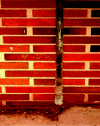Soil contamination from PCB-containing buildings
- PMID: 17384760
- PMCID: PMC1817698
- DOI: 10.1289/ehp.9646
Soil contamination from PCB-containing buildings
Abstract
Background: Polychlorinated biphenyls (PCBs) in construction materials, such as caulking used around windows and expansion joints, may constitute a source of PCB contamination in the building interiors and in surrounding soil. Several studies of soil contamination have been conducted around buildings where the caulking has been removed by grinding or scraping. The PCBs in soil may have been generated in the process of removing the caulking, but natural weathering and deterioration of the caulking may have also been a source.
Objectives: The objectives of this study were to measure PCB levels in soil surrounding buildings where PCB-containing caulk was still in place, and to evaluate the mobility of the PCBs from caulking using the Toxicity Characteristic Leaching Procedure (U.S. Environmental Protection Agency Method 1311).
Discussion: We found soil PCB contamination ranging from 3.3 to 34 mg/kg around buildings with undisturbed caulking that contained 10,000-36,200 mg/kg PCBs. The results of the Toxicity Characteristic Leaching Procedure (leachate concentrations of 76-288 mg PCB/L) suggest that PCBs in caulking can be mobilized, apparently as complexes with dissolved organic matter that also leach off the caulking material.
Conclusions and recommendations: Although these new findings are based on a small sample size, they demonstrate the need for a national survey of PCBs in building materials and in soil surrounding these buildings. Because the buildings constructed during the time the PCB caulking was in use (1960s and 1970s) include schools, hospitals, and apartment buildings, the potential for exposure of children is a particular concern. It is necessary to reconsider the practice of disposing of old PCB caulking removed during building renovations in conventional landfills, given the apparent mobility of PCBs from the caulking material. Disposal of some caulking material in nonhazardous landfills might lead to high PCB levels in landfill leachate.
Figures
Similar articles
-
An unrecognized source of PCB contamination in schools and other buildings.Environ Health Perspect. 2004 Jul;112(10):1051-3. doi: 10.1289/ehp.6912. Environ Health Perspect. 2004. PMID: 15238275 Free PMC article.
-
PCBs in school-persistent chemicals, persistent problems.New Solut. 2010;20(1):115-26. doi: 10.2190/NS.20.1.h. New Solut. 2010. PMID: 20359995
-
Serum PCB levels and congener profiles among US construction workers.Environ Health. 2007 Aug 31;6:25. doi: 10.1186/1476-069X-6-25. Environ Health. 2007. PMID: 17764566 Free PMC article.
-
Polychlorinated biphenyls (PCBs) in San Francisco Bay.Environ Res. 2007 Sep;105(1):67-86. doi: 10.1016/j.envres.2007.01.013. Epub 2007 Apr 23. Environ Res. 2007. PMID: 17451673 Review.
-
A spatial temporal assessment of pollution from PCBs in China.Chemosphere. 2005 Aug;60(6):731-9. doi: 10.1016/j.chemosphere.2005.05.001. Chemosphere. 2005. PMID: 15964056 Review.
Cited by
-
PCB remediation in schools: a review.Environ Sci Pollut Res Int. 2016 Feb;23(3):1986-97. doi: 10.1007/s11356-015-4689-y. Epub 2015 May 22. Environ Sci Pollut Res Int. 2016. PMID: 25994266 Review.
-
Passive-Sampler-Based Bioavailability Assessment of PCB Congeners Associated with Aroclor-Containing Paint Chips in the Presence of Sediment.Arch Environ Contam Toxicol. 2022 Jan;82(1):105-118. doi: 10.1007/s00244-021-00907-2. Epub 2021 Dec 17. Arch Environ Contam Toxicol. 2022. PMID: 34919163 Free PMC article.
-
The role of the gut microbiome in mediating neurotoxic outcomes to PCB exposure.Neurotoxicology. 2019 Dec;75:30-40. doi: 10.1016/j.neuro.2019.08.010. Epub 2019 Aug 24. Neurotoxicology. 2019. PMID: 31454514 Free PMC article. Review.
-
Life cycle of PCBs and contamination of the environment and of food products from animal origin.Environ Sci Pollut Res Int. 2018 Jun;25(17):16325-16343. doi: 10.1007/s11356-018-1811-y. Epub 2018 Mar 27. Environ Sci Pollut Res Int. 2018. PMID: 29589245
-
Is food type important for in vitro post ingestion bioaccessibility models of polychlorinated biphenyls sorbed to soil?Sci Total Environ. 2020 Feb 20;704:135421. doi: 10.1016/j.scitotenv.2019.135421. Epub 2019 Nov 23. Sci Total Environ. 2020. PMID: 31806324 Free PMC article.
References
-
- Balfanz E, Fuchs J, Kieper H. Sampling and analysis of polychlorinated biphenyls (PCB) in indoor air due to permanently elastic sealants. Chemosphere. 1993;26(5):871–880.
-
- Burkhardt U, Bork M, Balfanz E, Leidel J. Indoor air pollution by polychlorinated biphenyl compounds in permanently elastic sealants [in German] Offentl Gesundheitwes. 1990;52(10):567–574. - PubMed
-
- Coghlan KM, Chang, MP, Jessup, DS, Fragala, MA, McCrillis, K, Lockhart TM. 2002. Characterization of polychlorinated biphenyls in building materials and exposures in the indoor environment. In: Indoor Air 2002, Proceedings of the 9th International Conference on Indoor Air Quality and Climate, 30 June-5 July 2002, Monterey, CA, Vol 4 (Levin H, ed). Santa Cruz, CA:Indoor Air 2002, 147–152.
-
- Corner R, Sundahl M, Ek-Olausson B, Tysklind M. 2002. PCB in indoor air and dust in buildings in Stockholm. In: Indoor Air 2002, Proceedings of the 9th International Conference on Indoor Air Quality and Climate, 30 June–5 July 2002, Monterey, CA, Vol 4 (Levin H, ed). Santa Cruz, CA:Indoor Air 2002, 141–146.
-
- Fromme H, Baldauf AM, Klautke O, Piloty M, Bohrer L. Polychlorinated biphenyls (PCB) in caulking compounds of buildings—assessment of current status in Berlin and new indoor air sources [in German] Gesundheitswesen. 1996;58(12):666–672. - PubMed
Publication types
MeSH terms
Substances
Grants and funding
LinkOut - more resources
Full Text Sources
Other Literature Sources


